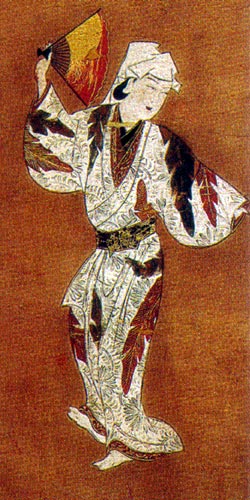| UKON GENZAEMON |
|
Stage name:
Existence: ??? ~ ??? Connections: Master: Murayama Sakon Son: Ukon Iwamatsu Disciples: Sakon Zenzaemon, Tamon Shôzaemon I Career: 1622: legendary birthyear of Ukon Genzaemon. 1629: Onna Kabuki ('Woman Kabuki') performances were forbidden by the Shogunal authorities. It is soon replaced by Wakashû Kabuki ('Boy Kabuki'). 1630's ~ 1640's: Ukon Genzaemon started his career in Kamigata in Wakashû Kabuki ('Boy Kabuki'). 1649: Ukon Genzaemon settled in Edo. 7th lunar month of 1652: Wakashû Kabuki was forbidden by by the Shogunal authorities. 3rd lunar month of 1653: Yarô Kabuki ('Adult Kabuki') was authorized by the Shogunal authorities. 2nd lunar month of 1672: Ukon Genzaemon performed at the Ichimuraza. End of the 1670s: Ukon Genzaemon died in Edo. Comments: Ukon Genzaemon, who was from Kamigata and started his career in Wakashû Kabuki ('Boy Kabuki'), became the first onnagata in Kabuki history. He was also the first kashagata. "As the actors of that time were forbidden to appear on the stage wearing long hair, but were obliged to shave the crown above the forehead, they covered their heads with a piece of silk to prevent the disfigurement from being seen. Ukon is described in the theatre gossip of the day as wearing an orange silk head-covering, and as he was a handsome youth and very womanly, it is easy to imagine that the Edo audiences were highly pleased with him. From the criticism of the time, he was considered beautiful, a fine dancer, but had no animation, and so became monotonous." (Zoë Kincaid in "Kabuki, the Popular Stage of Japan") "Good-looking actors in these troupes dressed as women, each vying to be more beautiful than the next. As a result, it was said, for example, that "Ukon Genzaemon, the first onnagata, [used] his sleeve in dance like that of a certain man long ago (mukashi otoko); he looked like a woman but was a man; his appearance was just like that of Narihira" ("Kokon Yakusha Monogatari" [Story of Actors Then and Now]). "The figure appears to be a woman but is very much a man; the very image of bisexual Narihira" ("Bokuyô Kyôkashû" [Collection of Bokuyô's Comic Poems]). Narihira is, of course, Ariwara no Narihira (825~880), "a certain man long ago", the poet hero of the "Ise Monogatari" [Tales of Ise], who is regarded as the paragon of male beauty in Japan. The expression in the satirical poem quoted above translated as "bisexual Narihira" (futanarihira) contains a pun on the word for "having both sets of genitalia" (futanari) like the statute of a hermaphrodite in the Louvre." (Kawatake Toshio in "Kabuki: Baroque Fusion of the Arts") |
 |
|
Ukon Genzaemon |
|
|
| Contact | Main | Top | Updates | Actors | Plays | Playwrights | Programs | Links | FAQ | Glossary | Chronology | Illustrations | Prints | Characters | Derivatives | Theaters | Coming soon | News |